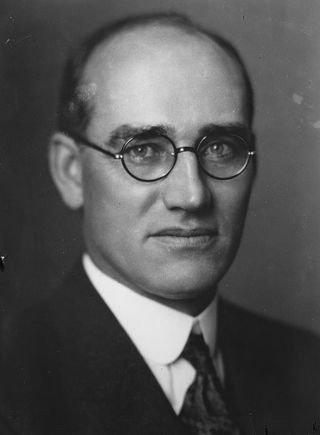
The 1946 United States Senate elections were held November 5, 1946, in the middle of Democratic President Harry S. Truman's first term after Roosevelt's passing. The 32 seats of Class 1 were contested in regular elections, and four special elections were held to fill vacancies. The Republicans took control of the Senate by picking up twelve seats, mostly from the Democrats. This was the first time since 1932 that the Republicans had held the Senate, recovering from a low of 16 seats following the 1936 Senate elections.

The 1936 United States Senate elections coincided with the reelection of President Franklin D. Roosevelt. The 32 seats of Class 2 were contested in regular elections, and special elections were held to fill vacancies. The Great Depression continued and voters backed progressive candidates favoring Roosevelt's New Deal in races across the country. The Democrats gained 5 net seats during the election, and in combination with Democratic and Farmer–Labor interim appointments and the defection of George W. Norris from the Republican Party to become independent, the Republicans were reduced to 16 seats. Democrats gained a further two seats due to mid-term vacancies. The Democrats' 77 seats and their 62-seat majority remain their largest in history.

The 1932 United States Senate elections coincided with Democrat Franklin D. Roosevelt's landslide victory over incumbent Herbert Hoover in the presidential election. The 32 seats of Class 3 were contested in regular elections, and special elections were held to fill vacancies.

Wilber Marion Brucker was an American Republican politician. Born in Saginaw, Michigan, he served as the 32nd governor of Michigan from 1931 to 1933 and as the United States Secretary of the Army between July 21, 1955, and January 19, 1961.

William Alfred Comstock was an American politician who served as the 33rd governor of Michigan.

The 1920 United States Senate election in Illinois took place on November 2, 1920.

The 1936 United States Senate election in Michigan was held on November 3, 1936. Incumbent Republican U.S. Senator James J. Couzens ran for re-election to a third term in office, but was defeated in the Republican primary by Governor Wilber Brucker. Brucker was defeated in the general election by Democratic U.S. Representative Prentiss M. Brown, becoming the first Democrat to win this seat since 1853.

The 1936 Michigan gubernatorial election was held on November 3, 1936. Democratic nominee Frank Murphy defeated incumbent Republican Frank Fitzgerald with 51.02% of the vote.

The 1938 Michigan gubernatorial election was held on November 8, 1938. Republican nominee Frank Fitzgerald defeated incumbent Democratic Frank Murphy with 52.78% of the vote.

The 1946 United States Senate election in New York was held on November 5, 1946.

The 1960 Michigan gubernatorial election was held on November 8, 1960. Democratic nominee John B. Swainson narrowly defeated Republican nominee Paul Douglas Bagwell with 50.48% of the vote.

The 1952 Michigan gubernatorial election was held on November 4, 1952. Incumbent Democrat G. Mennen Williams defeated Republican nominee Frederick M. Alger Jr. with 49.96% of the vote.

The 1926 Michigan gubernatorial election was held on November 2, 1926. Republican nominee Fred W. Green defeated Democratic nominee William Comstock with 63.35% of the vote.

The 1928 Michigan gubernatorial election was held on November 6, 1928. Incumbent Republican Fred W. Green defeated Democratic nominee William Comstock with 69.94% of the vote.

The 1930 Michigan gubernatorial election was held on November 4, 1930. Republican nominee Wilber M. Brucker defeated Democratic nominee William Comstock with 56.88% of the vote.

The 1934 Michigan gubernatorial election was held on November 6, 1934. Republican nominee Frank Fitzgerald defeated Democratic nominee Arthur J. Lacy with 52.41% of the vote.

The 1946 Michigan gubernatorial election was held on November 5, 1946. Republican nominee Kim Sigler defeated Democratic nominee Murray Van Wagoner with 60.28% of the vote.

The 1948 Michigan gubernatorial election was held on November 2, 1948. Democratic nominee G. Mennen Williams defeated incumbent Republican Kim Sigler with 53.41% of the vote.

The 1950 Michigan gubernatorial election was held on November 7, 1950. Incumbent Democrat G. Mennen Williams defeated Republican nominee Harry Kelly with 49.76% of the vote.

The 1932 Wisconsin gubernatorial election was held on November 8, 1932. Incumbent Republican Governor Philip La Follette was defeated in the Republican primary, and in the midst of the Great Depression and nationwide voter dissatisfaction with the Republican Party, Democratic nominee Albert G. Schmedeman defeated Republican nominee Walter J. Kohler Sr. and Socialist nominee Frank Metcalfe with 52.48% of the vote. Schmedeman became the first Democrat to win a gubernatorial election in Wisconsin since George Wilbur Peck in 1892. 2 years later, in 1934, La Follette would run for governor again and defeated Schmedeman, this time running with the Progressive Party.























